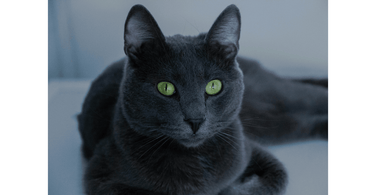By Francesca Lees, our in-house cat behaviourist and vet nurse
General cat breed profile
Originating from the Archangel Isles in Russia, the Russian Blue is a naturally occurring breed with a rich history dating back centuries. This distinct breed descended from the cats kept by the Russian czars, prized for their beautiful, shimmery blue-grey coats and vivid green eyes. Russian Blues are medium-sized cats with a plush, short coat that doesn't shed much, making them a popular choice for pet parents with cat allergies. Their hypoallergenic nature is due to lower levels of the glycoprotein Fel d 1, which is a common allergen found in cat saliva and dander.
Physical characteristics of a Russian Blue cat
These silver-blue cats are medium-size cat with a sleek, slender frame. Their coats are a distinctive silver-blue hue that's short and dense. Their eyes are bright green, just adding to their irresistible charm. These cats are the definition of captivating!
Origins of the breed
Russian Blues have a long history and some theories suggest they originated in Russia and were then brought to Europe in the 1800s. Others believe that the breed actually first came from Archangel Island (Arkhangelsk), in Northern Russia, which is why they are sometimes referred to as the Archangel Blues or Archangel Cats. Despite the uncertainty about their origins, it is known that the Russian Blue cat breed began to gain popularity in Europe and the United States in the early 20th century and were the favoured cat of Russian Czars.
Personality
Russian Blues are known for their gentle nature and loving personalities. Their key personality traits are that they are intelligent but somewhat quiet and reserved cats. They’re highly affectionate and loyal with their caregivers although can be a little shy around strangers. They enjoy interactive toys and games and can be very playful with those they trust.
Grooming
Minimal grooming required due to their short coat. Russian Blues typically have a single coat rather than a double coat. Their coat is short, dense, and plush, but it lacks the undercoat that many other breeds have. This lack of an undercoat contributes to their sleek appearance and also means they tend to shed less than breeds with double coats.
Exercise
Russian Blues are a playful breed and require some exercise each day however they will happily curl up and sleep on a warm bed. Having access to the outdoors can give them the opportunity to exhibit some natural feline behaviours such as hunting, climbing and exploring which they love to do. If you do not have a safe enough outdoor space to let your cat out then having an enclosed area such as a catio or a cat containment fenced garden can provide space for these cats to exhibit natural behaviours whilst keeping safe. Building shelves and cat trees where they can climb can be very beneficial for these cats.
Common health considerations when getting a Russian Blue
Generally these are healthy cats however they can be , but prone to conditions like hypertrophic cardiomyopathy (HCM). HCM is a genetic condition which affects the heart so regular check ups with a vet can help to detect and manage this condition early on.
Diet
Russian Blue cats can eat a diet of wet or dry food or a mixture of both. The key is to provide a balanced diet which meets their nutritional needs. As they are quite playful a diet which is rich in protein is essential for muscle development. Make sure to feed the right diet for their life stage (for example kitten food or neutered cat food). As with all cats, it's good to incorporate dry cat food recipes for dental health. Russian Blues also love treats and can be fed small amounts of cooked fish or chicken. However it is important to avoid giving your cat bones.
Habitat
Russian Blue cats can adapt to indoor living but may benefit from access to safe outdoor spaces. They enjoy high perches and shelves and elevated areas. They also love to cosy up in a warm, comfy area so providing them with a quiet spot to relax in is very important. Provide a cosy blanket or bed in a secluded area to keep your Russian Blue happy. Also providing toys and puzzle feeders can help with their playful nature. This also prevents boredom and behavioural issues which can arise from a lack of stimulation.
Popularity
Russian Blue cats have become a very sought after breed among cat lovers. This is due to their stunning looks, gentle and intelligent personality, their ability to form strong bonds with their human families and their need for minimal grooming. Recognised by various cat breed registries, including TICA and CFA, they are often seen at cat shows. Because they are popular cats to breed, they also often end up in cat rescues so if you do want a Russian Blue as a pet, it's best to contact local cat rescues before a breeder as it's almost certain there will be one looking for a new home.
Which type of pet parents are they best suited to
Russian Blue cats make great family pets and can be very happy living with children, however as with all cats children should be taught how to handle them gently and to respect the cats need for space. Russian Blues maybe more timid around a dog but if slowly introduced to a dog they can share a home with a canine friend.
Russian Blue cats would be suitable for a first-time pet owner but one who is prepared to provide play time activities and have daily play sessions with their cat. They would not be so suited to a caregiver who is out all day and who doesn’t have a great deal of time to spend with their cat.
Fun facts about Russian Blue Cats
- Musical purr: Russian Blues are known for having a soft and melodic purr, which some owners describe as resembling a gentle musical hum. It's soothing to listen to and adds to their charm.
- Sporty jumpers: Despite their elegant appearance, Russian Blues are excellent jumpers and climbers. They love to explore vertical spaces and may surprise you with their agility as they gracefully leap from one surface to another.
- Water fascination: Unlike some other cat breeds, Russian Blues are often fascinated by water!
- Mouse hunting heritage: Originating from Russia, these cats have a history of being skilled mouse hunters. Even though they're now cherished as indoor companions, they may still exhibit hunting behaviours, such as stalking and pouncing on toys or imaginary prey.
- Sensitive souls: Russian Blues are known to be sensitive to their owners' emotions and moods. They have an intuitive understanding of human feelings and may offer comfort by snuggling up or providing gentle companionship during times of distress.
Are Russian Blue cats suitable pets for people with allergies?
Russian Blue cats do not possess any unique coat characteristics that classify them as hypoallergenic, however, they do generate lower levels of Fel d1 - the protein that cats release from their skin that many individuals with allergies react to.
Summary
Russian Blues are intelligent, graceful cats known for their unique characteristics and playful personalities. While they may be reserved around strangers, they form strong bonds with their families and are loyal companions. These cats are prone to thrive in stable environments and don't typically like change much, making them ideal for families with older children or senior cat lovers. Despite their refined appearance, Russian Blues are playful and enjoy interactive playtime with their pet parents. Fun fact: Russian Blues may have been among the first cat breeds exhibited in cat shows, with records dating back to the Crystal Palace Cat Show in the U.S. and Europe. Additionally, they're sometimes referred to as Archangel cats, a nod to their supposed origins in the Archangel Isles. To help your Russian Blue thrive, ensure they receive measured amounts of high-quality cat food, regular exercise, and veterinary care to maintain their overall health and wellbeing.


My Lulu is a gorgeous cat! I love her and she adores me! She is so sweet that it makes my teeth hurt!
My Lulu is a gorgeous cat! I love her and she adores me! She is so sweet that it makes my teeth hurt!